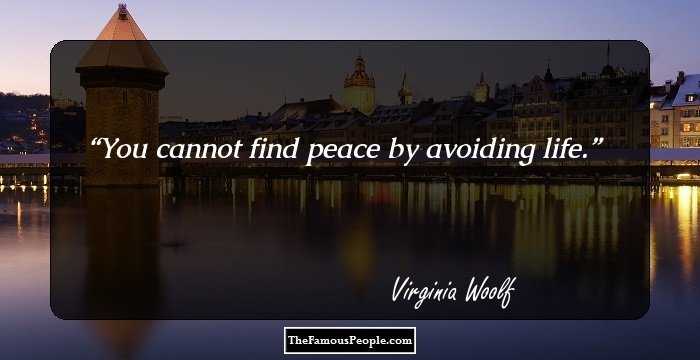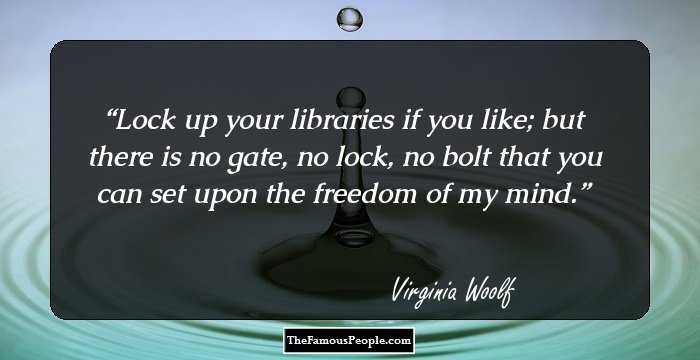Is House in Virginia Book on the Best Sellers List
Quick Facts
Altogether: January 25, 1882
Died At Age: 59
Sun Sign: Aquarius
Too Known As: Adeline Virginia Woolf, Adeline Virginia Stephen
Born Country: England
Born in: Kensington, London, England
Famous every bit: Novelist
Quotes By Virginia Woolf Novelists
Family:
Spouse/Ex-: Leonard Woolf
father: Sir Leslie Stephen
mother: Julia Prinsep Stephen (née Jackson)
siblings: Adrian Stephen, Thoby Stephen, Vanessa Bong
Died on: March 28, 1941
place of decease: Lewes, England
: By Drowning
City: London, England
Personality: INFP
Cause of Expiry: Suicide
More than Facts
didactics: King's College London
Recommended Lists:
Recommended Lists:
Who was Virginia Woolf?
Virginia Woolf was an English writer and novelist who wrote modernist classics. Non only is she known as a pioneer of modernism, but also as the greatest modernist literary personality of the twentieth century. She pioneered feminist texts as well. She is known for her works like 'To the Lighthouse,' 'Mrs. Dalloway,' 'Orlando,' and an essay titled 'A Room of One's Own.' An important figure in the 'Victorian Literary Society,' as well as an influential figure in the Bloomsbury grouping of intellectuals, Woolf was an innovator of English language literature who used experimental language. Her works are considered unique as they become deep into the psychology of a character, portraying the way her grapheme thinks. She published novels and essays, and received both critical and commercial success. She self-published near of her works through 'Hogarth Printing' which she co-founded. Throughout her life, she suffered from mental illnesses, and took her own life in 1941, at the age of 59. Her posthumous reputation suffered afterward the 'Second World War,' but was re-established with the growth of feminist criticism during the 1970s. Woolf's novels tin can be described as highly experimental. Her passion to find a new narration manner gave ascent to a unique combination of poetry and prose, making her works that much more than intriguing.
Recommended Lists:
Recommended Lists:
Recommended Lists:
Recommended Lists:
Babyhood & Early on Life
Virginia Woolf was born Adeline Virginia Stephen on 25 January 1882, in South Kensington, London, England. Her parents, Sir Leslie Stephen, an editor and a critic, and Julia Prinsep Stephen, a photographer, were freethinking people. They educated her in their own literate and well-continued business firm. Since both her parents had been previously married, she grew up with several half-siblings.
Because her begetter was an editor, she grew up in an environment that had the influence of the Victorian literary society. There was a library in their business firm, from which the children were taught classics and English literature. Her brothers were educated at Cambridge and they often brought home literary works from Cambridge, which helped boost her intellect.
Her family unit fabricated annual summer migrations from their London townhouse to the Talland House, situated on the rugged Cornwall coast. This annual relocation gave her an opportunity to experience the dualities, such as winter and summer, repression and liberty, metropolis and country, etc.
Her mother passed away in 1895, and her sis passed abroad two years later, leaving Woolf in a state of shock. She lost her father in 1904, which had a severe touch on on her mental stability. It was revealed later, that she suffered sexual corruption at the hands of her half-brothers, farther adding to her trauma.

Quotes: I
Y'all May Similar
Recommended Lists:
Recommended Lists:
Career
Virginia Woolf began writing professionally in 1900. The first of her writings, which was a journalistic business relationship of a visit to the Bronte family unit, was published anonymously in a journal in December 1904. She started writing for 'The Times Literary Supplement' the post-obit year.
In 1915, she published her first novel 'The Voyage Out,' which was originally titled 'Melymbrosia.' The volume was mostly nearly the experiences encountered in her life. She connected writings novels, self-publishing well-nigh of them, and gradually became a popular figure in the Victorian literary society.
In 1928, Virginia Woolf started taking grassroots approach to advocate feminism. She started addressing undergraduate women in diverse colleges. 'A Room of One's Own' (1929) and 'Iii Guineas' (1938) were 2 of her non-fiction works that hash out the hardships faced by women writers and intellectuals. Also, she wanted to brand people realize the effects of industrialization as well equally create awareness well-nigh nascency control.
It was during the bombing of London in 1940 and 1941 that she worked on 'Between the Acts' which portrayed state of war as a threat to art and humanity. Though she raised several questions in this piece of work, she later on felt that her work was of little significance as England seemed to be on the verge of invasion. It was such horrors that made it hard for her to write. She was also plagued by mental illnesses, leading to her suicide in 1941. Her work was published later that year after her death.
With the end of the 'Second World State of war,' her posthumous popularity suffered. Yet, her works gained popularity again in the 1970s with the advent of feminist criticism. Despite her fame, she earned criticism for being anti-Semitic and for her snobbery—attributes that she claimed to own in her personal diary.

Recommended Lists:
Recommended Lists:
Major Works
Her commencement piece of work 'The Voyage Out' was published on 26 March 1915 by her half-brother Duckworth's visitor. Information technology was written when she was psychologically vulnerable, and suffering from low.
In 1981, an alternate version of 'The Voyage Out,' nether its original title 'Melymbrosia,' was published by an American writer, editor, and Professor Louise DeSalvo. DeSalvo claimed that the release of the alternating version was an endeavor to restore the novel equally Woolf had originally conceived it. The work included subjects like homosexuality, women'southward issues, and colonialism. Since Woolf had been warned by her colleagues that publishing such an outspoken piece of work would bear upon her career, the original version had been heavily edited.
'To the Lighthouse' was ane of her important works. It was published in 1927 by 'Hogarth Press'—which she had co-founded with her hubby. What's unique about this novel is that it contains little dialogue, and almost no action, as most of it was written every bit thoughts and observations. Childhood emotions were recalled and developed relationships were highlighted. She had begun writing this book equally a way of understanding as well equally dealing with unresolved issues concerning her parents. Hence, similarities with her life tin be seen in the book.
'The Waves' was published in 1931. It was i of her nearly experimental novels. It consists of six characters, through which Virginia Woolf explores concepts of individuality, self, and community. It is difficult to assign a genre to this novel, because of its complexity. In fact, the book cannot fifty-fifty be categorized as a novel because of its complexity. As described in Woolf's biography, it is less of a novel and more of a 'playpoem.' The book was translated past Marguerite Yourcenar in 1937.
'Flush: A Biography' was published in 1933 by 'Hogarth Press.' The book, which views city life through the eyes of a dog, is a harsh criticism of the unnatural ways adopted past the people living in the city. Woolf's emotional and philosophical views are verbalized in this book.
Awards & Achievements
Her work 'To the Lighthouse' was ranked number 15 past the 'Modernistic Library' in 1998, on its listing of '100 all-time English linguistic communication novels of the 20th century.' The 'Fourth dimension' magazine also chose it as i of the best English language novels published betwixt 1923 and 2005.

Personal Life & Legacy
Virginia Stephen married writer Leonard Woolf in 1912. They shared a shut bond and led a happy married life, which lasted until her death in 1941. The two too collaborated professionally.
She was bisexual and believed in exploring her sexuality. In 1922, she met a writer and gardener named Vita Sackville, with whom she had a sexual relationship.
Because of the trauma she endured in her childhood, she suffered from mental illnesses for well-nigh of her life. Unable to bear it anymore, she committed suicide by filling her pockets with stones and so drowning herself in a river on 28 March 1941. Her trunk was found on eighteen April, 1941. Her husband Leonard buried her cremated remains in the garden of their house in Sussex.
Source: https://www.thefamouspeople.com/profiles/virginia-woolf-30.php
Post a Comment for "Is House in Virginia Book on the Best Sellers List"